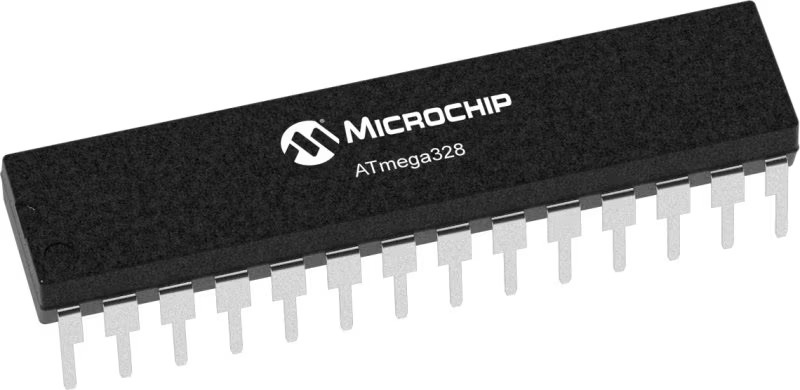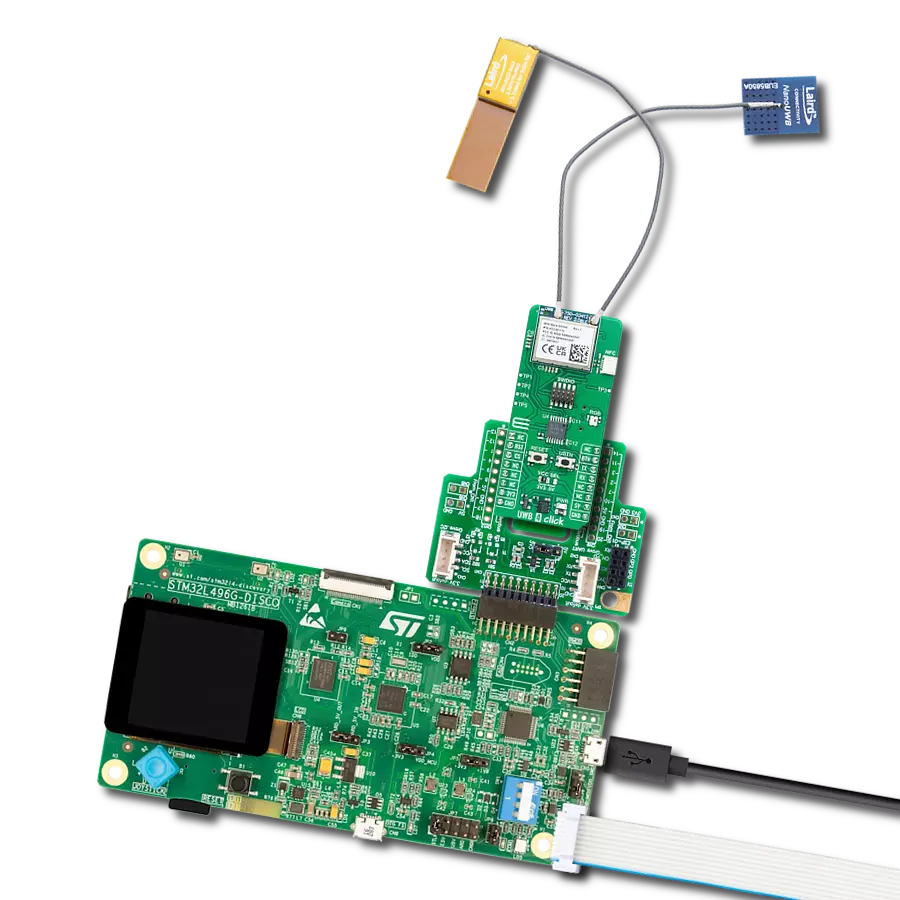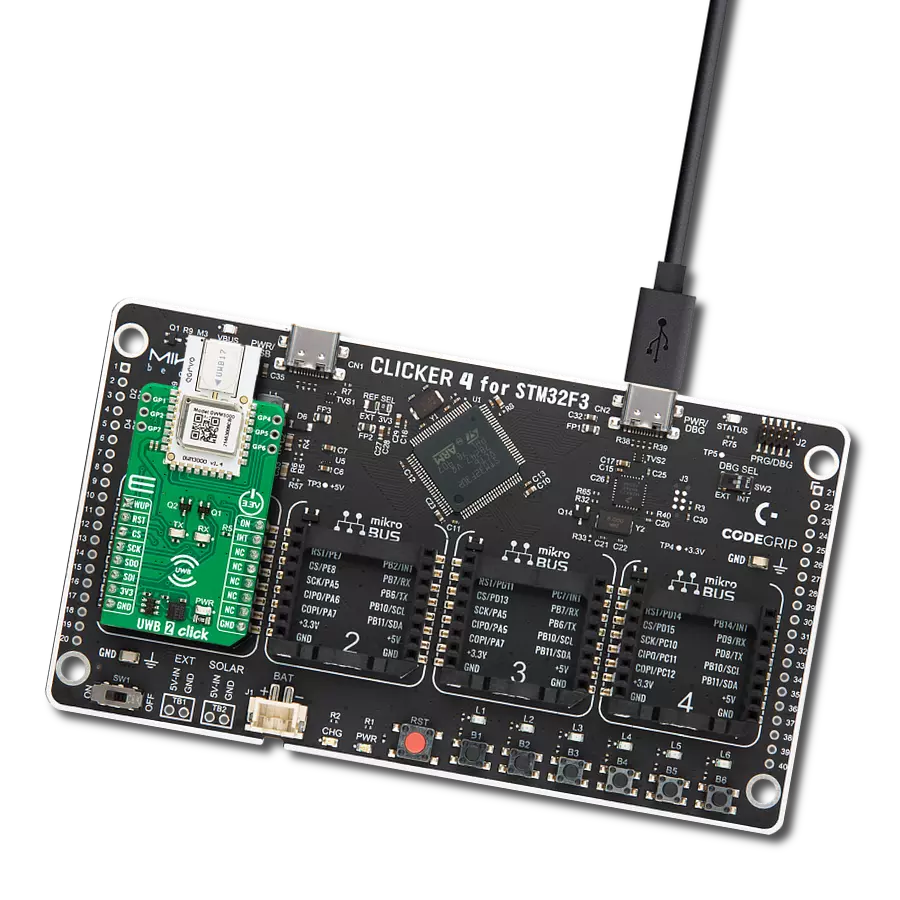It's useful for creating systems that require precise location tracking, like tracking the location of objects or devices in real-time.
A
A
Hardware Overview
How does it work?
UWB 3 Click is based on the DWM3001, a fully integrated UWB transceiver module from Qorvo. The module can be used in two-way ranging and TDoA applications. It is designed to comply with the FiRa™ PHY and MAC specifications, enabling interoperability with other FiRa™-compliant devices. It supports channels 5 (6.5GHz) and 9 (8GHz) and data rates of 850Kbps up to 6.8Mbps with a maximum packet length of 1023 bytes for high data throughput applications. Besides the planar UWB printed antenna, there is also a Bluetooth chip antenna for an onboard Nordic Cortex-M4 32-bit MCU with 64MHz clock speed for utilizing a BLE radio transceiver. This Nordic MCU is the brain of the module. The nRF52833 has advanced on-chip interfaces, such as NFC-A and USB 2.0 (full-speed 12Mbps), available on UWB 3
Click in a USB C form. The DWM3001 UWB transceiver also incorporates the LIS12DH, a low-power three-axis linear accelerometer from STMicroelectronics. It is necessary as RTLS tags commonly use accelerometers to initiate UWB ranging only when a tag moves so that battery life can be extended by staying in the lowest power mode by default. Near-field communication type 2 (NFC-A) can be used by adding an NFC antenna to the TP1 and TP2 pads. UWB 3 Click can use a standard 2-Wire UART interface of the nRF52833 to communicate with the host MCU with commonly used UART RX and TX pins and baud rates of 115200bps. There are RX and TX LEDs for visual presentation of data flow. It can also use a 4-Wire SPI serial interface on 32MHz for communication. The I2C interface, besides the communication
with the Nordic MCU, allows you to read the data from the accelerometer. It should be noted that the current module firmware does not support the SPI and I2C serial interfaces; these interfaces are reserved for future use. You can reset the module over the RST pin but also over the RESET button. The nRF52833 firmware can be updated over the SWDIO 6-pin needle connector. This Click board™ can be operated only with a 3.3V logic voltage level. The board must perform appropriate logic voltage level conversion before using MCUs with different logic levels. Also, this Click board™ comes equipped with a library containing easy-to-use functions and an example code that can be used as a reference for further development.
Features overview
Development board
Arduino UNO is a versatile microcontroller board built around the ATmega328P chip. It offers extensive connectivity options for various projects, featuring 14 digital input/output pins, six of which are PWM-capable, along with six analog inputs. Its core components include a 16MHz ceramic resonator, a USB connection, a power jack, an
ICSP header, and a reset button, providing everything necessary to power and program the board. The Uno is ready to go, whether connected to a computer via USB or powered by an AC-to-DC adapter or battery. As the first USB Arduino board, it serves as the benchmark for the Arduino platform, with "Uno" symbolizing its status as the
first in a series. This name choice, meaning "one" in Italian, commemorates the launch of Arduino Software (IDE) 1.0. Initially introduced alongside version 1.0 of the Arduino Software (IDE), the Uno has since become the foundational model for subsequent Arduino releases, embodying the platform's evolution.
Microcontroller Overview
MCU Card / MCU

Architecture
AVR
MCU Memory (KB)
32
Silicon Vendor
Microchip
Pin count
32
RAM (Bytes)
2048
You complete me!
Accessories
Click Shield for Arduino UNO has two proprietary mikroBUS™ sockets, allowing all the Click board™ devices to be interfaced with the Arduino UNO board without effort. The Arduino Uno, a microcontroller board based on the ATmega328P, provides an affordable and flexible way for users to try out new concepts and build prototypes with the ATmega328P microcontroller from various combinations of performance, power consumption, and features. The Arduino Uno has 14 digital input/output pins (of which six can be used as PWM outputs), six analog inputs, a 16 MHz ceramic resonator (CSTCE16M0V53-R0), a USB connection, a power jack, an ICSP header, and reset button. Most of the ATmega328P microcontroller pins are brought to the IO pins on the left and right edge of the board, which are then connected to two existing mikroBUS™ sockets. This Click Shield also has several switches that perform functions such as selecting the logic levels of analog signals on mikroBUS™ sockets and selecting logic voltage levels of the mikroBUS™ sockets themselves. Besides, the user is offered the possibility of using any Click board™ with the help of existing bidirectional level-shifting voltage translators, regardless of whether the Click board™ operates at a 3.3V or 5V logic voltage level. Once you connect the Arduino UNO board with our Click Shield for Arduino UNO, you can access hundreds of Click boards™, working with 3.3V or 5V logic voltage levels.
Used MCU Pins
mikroBUS™ mapper
Take a closer look
Click board™ Schematic

Step by step
Project assembly
Track your results in real time
Application Output
1. Application Output - In Debug mode, the 'Application Output' window enables real-time data monitoring, offering direct insight into execution results. Ensure proper data display by configuring the environment correctly using the provided tutorial.

2. UART Terminal - Use the UART Terminal to monitor data transmission via a USB to UART converter, allowing direct communication between the Click board™ and your development system. Configure the baud rate and other serial settings according to your project's requirements to ensure proper functionality. For step-by-step setup instructions, refer to the provided tutorial.

3. Plot Output - The Plot feature offers a powerful way to visualize real-time sensor data, enabling trend analysis, debugging, and comparison of multiple data points. To set it up correctly, follow the provided tutorial, which includes a step-by-step example of using the Plot feature to display Click board™ readings. To use the Plot feature in your code, use the function: plot(*insert_graph_name*, variable_name);. This is a general format, and it is up to the user to replace 'insert_graph_name' with the actual graph name and 'variable_name' with the parameter to be displayed.

Software Support
Library Description
This library contains API for UWB 3 Click driver.
Key functions:
uwb3_send_cmd- This function sends a specified command to the click module.uwb3_send_cmd_with_parameter- This function sends a command with specified parameter to the click module.uwb3_reset_device- This function resets the device by toggling the RST pin state.
Open Source
Code example
The complete application code and a ready-to-use project are available through the NECTO Studio Package Manager for direct installation in the NECTO Studio. The application code can also be found on the MIKROE GitHub account.
/*!
* @file main.c
* @brief UWB 3 Click Example.
*
* # Description
* This example demonstrates the use of an UWB 3 Click board by showing
* the communication between the two Click boards.
*
* The demo application is composed of two sections :
*
* ## Application Init
* Initializes the driver and configures the Click board for the selected
* application mode.
*
* ## Application Task
* Reads and processes all incoming ranging block messages and displays them
* on the USB UART. One Click board should be configured to initiator mode and
* the others to responder 1 or 2. The initiator Click displays the address
* and distance of each responder nodes, while the responder Click boards displays
* the address and distance of the initiator Click board.
*
* ## Additional Function
* - static void uwb3_clear_app_buf ( void )
* - static void uwb3_log_app_buf ( void )
* - static err_t uwb3_process ( uwb3_t *ctx )
* - static err_t uwb3_display_response ( uwb3_t *ctx )
* - static err_t uwb3_parse_ranging_block ( void )
*
* @author Stefan Filipovic
*
*/
#include "board.h"
#include "log.h"
#include "uwb3.h"
// Demo aplication selection macros
#define APP_INITIATOR 0
#define APP_RESPONDER_1 1
#define APP_RESPONDER_2 2
#define DEMO_APP APP_INITIATOR
/** INITF/RESPF parameter list and default value
* Order Config Param Default value Description
* #1 RFRAME BPRF 4 RFRAME BRFF set as per FiRa spec:
* 4 - SP3 SFD4Z, 6 - SP3 SFD4A
* #2 RSTU slot duration 2400 Duration of the slot in RSTU time units.
* 1ms = 1200 RSTU
* #3 Block duration ms 200 Duration of the FiRa ranging block in ms
* #4 Round duration slots 25 Duration of the FiRa ranging round inside
* the block
* #5 Ranging Round usage 2 0 - Not used, 1 - SS-TWR, 2 - DS-TWR
* #6 Session ID 42 Session ID
* #7 vupper64 01:02:03:04:05:06:07:08 Eight hexadecimal numbers, represented
* static part of the STS in FiRa standard,
* Hex values separated by ":"
* #8 Multi node mode 0 0 for unicast, 1 for multi-node configuration
* #9 Round hopping 0 0 for no round hopping, 1 for round hopping
* #10 Initiator address 0 Address of FiRa Initiator, Decimal value 0-65535
* #11 Responder address 1 Address of responder or set of addresses for
* multiple responders, Decimal value 0-65535
*/
#define INITIATOR_CONFIG "4 2400 200 25 2 42 01:02:03:04:05:06:07:08 1 0 0 1 2"
#define RESPONDER_1_CONFIG "4 2400 200 25 2 42 01:02:03:04:05:06:07:08 1 0 0 1"
#define RESPONDER_2_CONFIG "4 2400 200 25 2 42 01:02:03:04:05:06:07:08 1 0 0 2"
// Application buffer size
#define APP_BUFFER_SIZE 800
#define PROCESS_BUFFER_SIZE 200
static uwb3_t uwb3;
static log_t logger;
static uint8_t app_buf[ APP_BUFFER_SIZE ] = { 0 };
static int32_t app_buf_len = 0;
/**
* @brief UWB 3 clearing application buffer.
* @details This function clears memory of application buffer and reset its length.
* @note None.
*/
static void uwb3_clear_app_buf ( void );
/**
* @brief UWB 3 log application buffer.
* @details This function logs data from application buffer to USB UART.
* @note None.
*/
static void uwb3_log_app_buf ( void );
/**
* @brief UWB 3 data reading function.
* @details This function reads data from device and concatenates data to application buffer.
* @param[in] ctx : Click context object.
* See #uwb3_t object definition for detailed explanation.
* @return @li @c 0 - Read some data.
* @li @c -1 - Nothing is read.
* See #err_t definition for detailed explanation.
* @note None.
*/
static err_t uwb3_process ( uwb3_t *ctx );
/**
* @brief UWB 3 display response function.
* @details This function reads and displays the response to previously sent command.
* @param[in] ctx : Click context object.
* See #uwb3_t object definition for detailed explanation.
* @return @li @c 0 - OK response.
* @li @c -2 - Timeout error.
* See #err_t definition for detailed explanation.
*/
static err_t uwb3_display_response ( uwb3_t *ctx );
/**
* @brief UWB 3 parse ranging block function.
* @details This function parses the ranging block results from application buffer and
* displays it to the USB UART.
* @return @li @c 0 - Ranging block data parsed successfully.
* @li @c -1 - No valid ranging block data in application buffer.
* See #err_t definition for detailed explanation.
*/
static err_t uwb3_parse_ranging_block ( void );
void application_init ( void )
{
log_cfg_t log_cfg; /**< Logger config object. */
uwb3_cfg_t uwb3_cfg; /**< Click config object. */
/**
* Logger initialization.
* Default baud rate: 115200
* Default log level: LOG_LEVEL_DEBUG
* @note If USB_UART_RX and USB_UART_TX
* are defined as HAL_PIN_NC, you will
* need to define them manually for log to work.
* See @b LOG_MAP_USB_UART macro definition for detailed explanation.
*/
LOG_MAP_USB_UART( log_cfg );
log_init( &logger, &log_cfg );
log_info( &logger, " Application Init " );
// Click initialization.
uwb3_cfg_setup( &uwb3_cfg );
UWB3_MAP_MIKROBUS( uwb3_cfg, MIKROBUS_1 );
if ( UART_ERROR == uwb3_init( &uwb3, &uwb3_cfg ) )
{
log_error( &logger, " Communication init." );
for ( ; ; );
}
// Clear buffers
uwb3_process( &uwb3 );
uwb3_clear_app_buf( );
// Switch to stop mode
uwb3_send_cmd ( &uwb3, UWB3_CMD_STOP );
uwb3_display_response ( &uwb3 );
Delay_ms ( 1000 );
#if ( DEMO_APP == APP_RESPONDER_1 )
uwb3_send_cmd_with_parameter ( &uwb3, UWB3_CMD_RESPF, RESPONDER_1_CONFIG );
uwb3_display_response ( &uwb3 );
log_printf( &logger, "Application Mode: Responder 1\r\n" );
#elif ( DEMO_APP == APP_RESPONDER_2 )
uwb3_send_cmd_with_parameter ( &uwb3, UWB3_CMD_RESPF, RESPONDER_2_CONFIG );
uwb3_display_response ( &uwb3 );
log_printf( &logger, "Application Mode: Responder 2\r\n" );
#else
uwb3_send_cmd_with_parameter ( &uwb3, UWB3_CMD_INITF, INITIATOR_CONFIG );
uwb3_display_response ( &uwb3 );
log_printf( &logger, "Application Mode: Initiator\r\n" );
#endif
uwb3_clear_app_buf( );
log_info( &logger, " Application Task " );
}
void application_task ( void )
{
if ( UWB3_OK == uwb3_process( &uwb3 ) )
{
if ( UWB3_OK == uwb3_parse_ranging_block ( ) )
{
uwb3_clear_app_buf( );
}
}
}
int main ( void )
{
/* Do not remove this line or clock might not be set correctly. */
#ifdef PREINIT_SUPPORTED
preinit();
#endif
application_init( );
for ( ; ; )
{
application_task( );
}
return 0;
}
static void uwb3_clear_app_buf ( void )
{
memset( app_buf, 0, app_buf_len );
app_buf_len = 0;
}
static void uwb3_log_app_buf ( void )
{
for ( int32_t buf_cnt = 0; buf_cnt < app_buf_len; buf_cnt++ )
{
log_printf( &logger, "%c", app_buf[ buf_cnt ] );
}
}
static err_t uwb3_process ( uwb3_t *ctx )
{
uint8_t rx_buf[ PROCESS_BUFFER_SIZE ] = { 0 };
int32_t overflow_bytes = 0;
int32_t rx_cnt = 0;
int32_t rx_size = uwb3_generic_read( ctx, rx_buf, PROCESS_BUFFER_SIZE );
if ( ( rx_size > 0 ) && ( rx_size <= APP_BUFFER_SIZE ) )
{
if ( ( app_buf_len + rx_size ) > APP_BUFFER_SIZE )
{
overflow_bytes = ( app_buf_len + rx_size ) - APP_BUFFER_SIZE;
app_buf_len = APP_BUFFER_SIZE - rx_size;
memmove ( app_buf, &app_buf[ overflow_bytes ], app_buf_len );
memset ( &app_buf[ app_buf_len ], 0, overflow_bytes );
}
for ( rx_cnt = 0; rx_cnt < rx_size; rx_cnt++ )
{
if ( rx_buf[ rx_cnt ] )
{
app_buf[ app_buf_len++ ] = rx_buf[ rx_cnt ];
}
}
return UWB3_OK;
}
return UWB3_ERROR;
}
static err_t uwb3_display_response ( uwb3_t *ctx )
{
uint32_t timeout_cnt = 0;
uint32_t timeout = 10000;
uwb3_clear_app_buf( );
uwb3_process( ctx );
while ( ( 0 == strstr( app_buf, UWB3_RSP_OK ) ) &&
( 0 == strstr( app_buf, UWB3_RSP_ERROR ) ) )
{
uwb3_process( ctx );
if ( timeout_cnt++ > timeout )
{
uwb3_clear_app_buf( );
log_error( &logger, " Timeout!" );
return UWB3_ERROR_TIMEOUT;
}
Delay_ms ( 1 );
}
Delay_ms ( 100 );
uwb3_process( ctx );
uwb3_log_app_buf ( );
log_printf( &logger, "--------------------------\r\n" );
return UWB3_OK;
}
static err_t uwb3_parse_ranging_block ( void )
{
uint8_t * __generic_ptr start_block_ptr = NULL;
uint8_t * __generic_ptr end_block_ptr = NULL;
uint8_t * __generic_ptr results_ptr = NULL;
start_block_ptr = &app_buf[ 0 ];
for ( ; ; )
{
start_block_ptr = strstr( start_block_ptr, "\"Block\"" );
if ( !start_block_ptr )
{
return UWB3_ERROR;
}
end_block_ptr = strstr( start_block_ptr, "\r\n" );
if ( !end_block_ptr )
{
return UWB3_ERROR;
}
results_ptr = strstr( start_block_ptr, "\"Status\":\"Ok\"" );
if ( results_ptr && ( ( uint32_t ) results_ptr < ( uint32_t ) end_block_ptr ) )
{
log_printf( &logger, "######### " );
while ( ',' != *start_block_ptr )
{
log_printf( &logger, "%c", *start_block_ptr );
start_block_ptr++;
}
log_printf( &logger, " #########\r\n\n" );
while ( results_ptr && ( ( uint32_t ) results_ptr < ( uint32_t ) end_block_ptr ) )
{
// Display node address
results_ptr -= 16;
while ( ',' != *results_ptr )
{
log_printf( &logger, "%c", *results_ptr );
results_ptr++;
}
log_printf( &logger, "\r\n" );
// Display node distance
results_ptr = strstr( results_ptr, "\"D_cm\"" );
while ( ',' != *results_ptr )
{
log_printf( &logger, "%c", *results_ptr );
results_ptr++;
}
log_printf( &logger, "\r\n\n" );
results_ptr = strstr( results_ptr, "\"Status\":\"Ok\"" );
}
return UWB3_OK;
}
start_block_ptr = end_block_ptr;
}
}
// ------------------------------------------------------------------------ END
Additional Support
Resources
Category:UWB

































